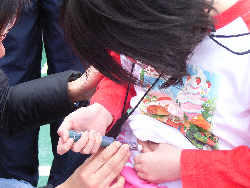Insulin is needed to help glucose enter the body’s cells so it can be turned into energy. This hormone is used by doctors to treat diabetes when the body cannot make enough insulin on its own. There are many types of insulin injections, both short and long-acting. When your doctors work out a care plan for you, the insulin injections will be based on your blood glucose levels.
How to take insulin
Insulin cannot be swallowed because your stomach will digest it before the insulin has done its work in controlling your blood glucose. That’s why it needs to be injected.
Insulin injection

Most people will use a pen when they are first told they need to give themselves insulin. Your doctor or nurse will show you how to use it. Your mum and dad or someone else might give you your injection, or you might do it yourself, if you are ready. There are a few places on your body where insulin can be injected:
- tummy
- thighs
- bottom
- arms (only if your nurse says it’s OK and there is someone to help you).
Injections can be scary, and this might make you want to do it slowly. But it will actually hurt less if you do it quickly. Try to relax and think about something else while you are having your injection. Perhaps sing a song or look at a special book.
Why your dose may change
As your body grows, you will need more insulin to control blood glucose. A person who is 18 years old will need 4 times more insulin than an 8-year old. The result of your blood tests will tell you and your doctor when and how much to increase insulin. These tests are as important as taking insulin.
Insulin pump
Using an insulin pump can provide better control and more flexibility during mealtimes compared to taking daily insulin injections. The insulin pump releases insulin continuously into the body throughout the day and also increases the amount of insulin before meals in order to maintain good blood sugar level.
Insulin pumps allows for more flexibility when it comes to meals or snacks times. There may also not be a need to have insulin injections three times a day.





